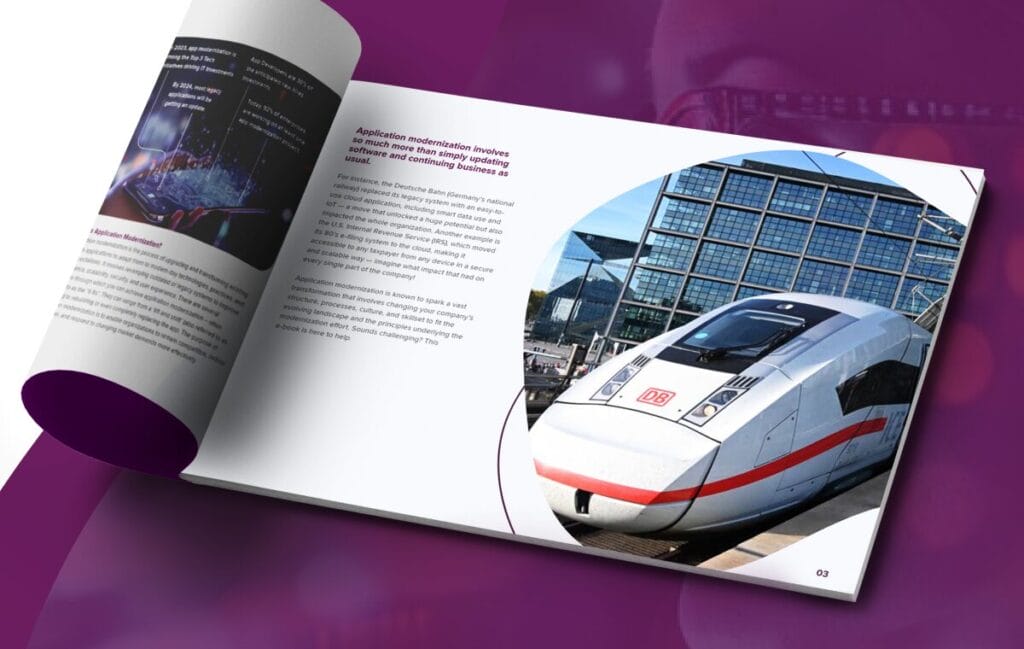Sometimes it is very hard for customers to understand the hidden costs involved when you build custom software. By a hidden cost, I mean a phenomenon that apparently is back in our industry called BitRot.
What is BitRot?
Back in the day, BitRot was caused by the fact that the magnetic media we used to store our computer programs sometimes lost their magnetic information, causing problems reading the data back. With the industry moving to new ways to store data, like solid-state drives, the problem is still there but not predominantly visible anymore. We have algorithms that store our data in such a way that the lost data can be recovered, and from an end-user perspective, BitRot seems to have vanished completely.
 Data degration – Wikipedia
Data degration – Wikipedia
BitRot redefined
Although the original problem has gone more or less away, we are now confronted with a completely new way that bitrot is coming back in our industry. You might disagree with me about reusing the name BitRot for something different, but in essence, the problem we face manifests itself in the same way. If we don’t touch the software, we write for even a few weeks, the software deteriorates!
Let me explain what is going on here.
BitRot today is the issue when we don’t touch our software for a few days or weeks, and the software deteriorates caused by a number of sources. Let me share a few of the issues you will face when building software today.
New known vulnerabilities
A known vulnerability is some weakness found in the software you wrote or in any software you used to build your application or website that someone can exploit. You might think, why would my software all of a sudden become exploitable while I haven’t touched it? This is caused by the fact that attackers become smarter each day. They find new innovative ways to exploit software. Since the software that is written often contains tons of code not only written by your own company but also open source components, the chance of your software becoming vulnerable itself is a significant risk. This does not immediately mean your software will be exploited as well, but the likelihood that your software becomes exploitable will increase almost every day. This is something you need to keep track of and you need to make updates or changes to your software to keep up with the current state of the industry. The number of vulnerabilities found is also increasing all the time. You can see how fast this is picking up in the following graph the NVD publishes[1]. I added a capture of the chart that shows how many known vulnerabilities are found and that the rate of finding them is constantly increasing.
CVSS Severity Distribution Over Time
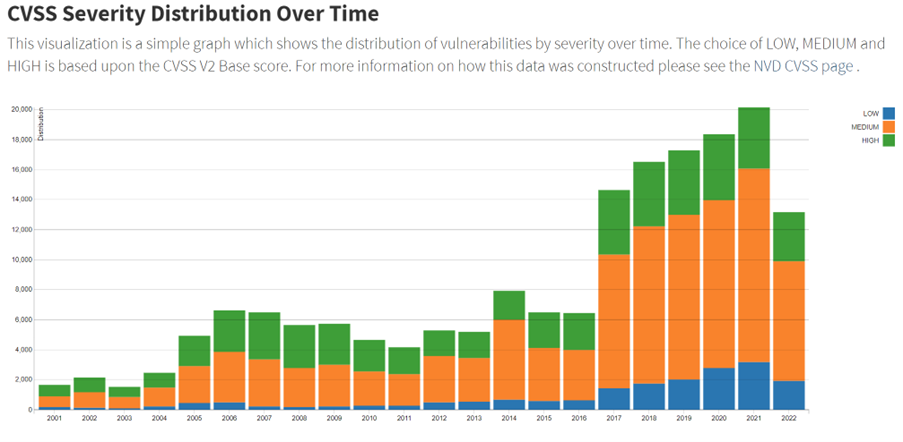 NVD – CVSS Severity Distribution Over Time (nist.gov)
NVD – CVSS Severity Distribution Over Time (nist.gov)
Updates of used frameworks or packages
Your software is rarely built from scratch. To build software, you will use other software components all the time. Depending on the technology you use to write your programs, you use NuGet packages (.NET), Maven packages (Java), Node Packages (Node/Web Development), RubyGems (Ruby development), etc. These packages are built and maintained by others and, coming back to the previous topic, they also need to maintain their software to keep it free from known vulnerabilities. Also, they want to provide new capabilities and features constantly. This implies those packages will get new versions all the time, and keeping up with those more recent versions is not to be taken lightly.
Let’s assume you build a simple Hello World web application using .NET 6 and React. You can see the screenshot of what I did to create the application in Visual Studio 2022:
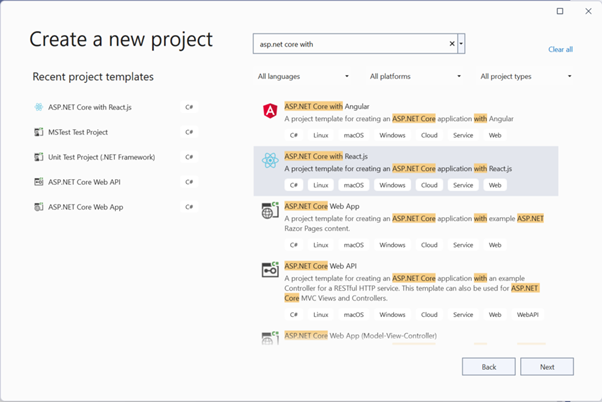 New ASP.NET with React project
New ASP.NET with React project
This will result in an astonishing set of from the NodeJS ecosystem and 15 more from the .NET ecosystem. Starting with a clean template (I updated everything before I created the application in Visual Studio), this already resulted in 23 Known Vulnerabilities of which 9 are at the level of High!
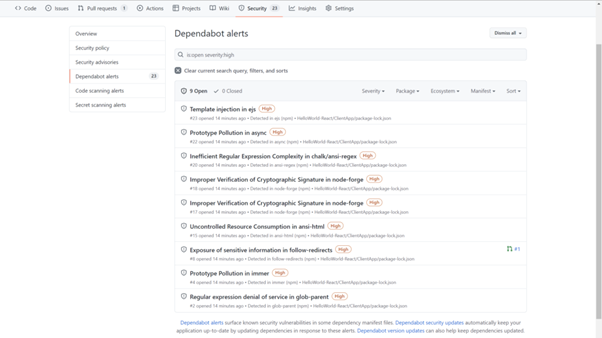 Analysis of new project with Dependabot (GitHub)
Analysis of new project with Dependabot (GitHub)
Updates on compilers and tooling
Then there are the dependencies on Visual Studio 2022, which has updates at least once every month. We took a dependency on the .NET framework that is updated at least and every two years has a new stable release that is supported for a maximum of 3 years. Not to mention all the small updates that might come to fix bugs and vulnerabilities. And finally, we took a dependency on the NodeJS toolset, which is also updated multiple times a year. These tools also tend to make breaking changes. You must constantly keep them up to date because they can also contain known vulnerabilities that might compromise your development environment!
Newer versions of the languages and frameworks
Finally, there are also dependencies on the languages we use. In this example, I used React which is Javascript/typescript based, and C#10 for the .NET codebase. C# is updated on a yearly cycle, and if you look
at the versions of Node, then you see you need to update this every six months:
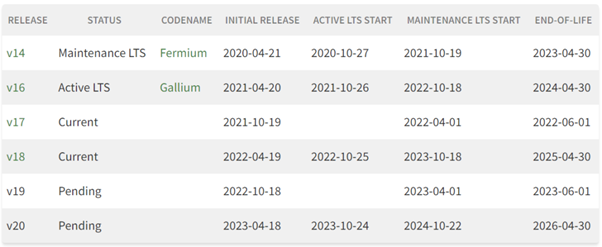 Releases – Node.js (nodejs.org)
Releases – Node.js (nodejs.org)
Those language and framework updates can be significant if you look at the amount of work involved to actually use the new capabilities. Not using them still makes your codebase deteriorate from a maintainability perspective since the industry is moving on with new ways of utilizing the language and framework features. New team members on a project will have a hard time adapting old programming styles and inefficiencies if you only ensure it compiles.
How can we mitigate this issue?
First of all, the most important thing is that you allocate time to keep things clean. This means allocating a certain budget of time to keep your packages up to date and spending time updating to newer minor or major versions of packages that come available. There is no silver bullet in solving this issue, but taking the time for it is one step in the right direction.
Secondly, you can automate some of this when you are using, e.g., GitHub as a DevOps platform. Here you have the option to enable a feature called Dependabot that will inform you that your packages are out of date or contain known vulnerabilities. When it knows the vulnerability can be mitigated with a new package version, it will even create a pull request for you. You still need to review it and approve the PR, so it becomes part of the main codebase. There are also tools that can integrate with most DevOps platforms to manage automated updates for you e.g. Renovate[1].
And then the final check is, when do I take the dependency? Be very aware of the fact that taking the dependency adds a maintenance cost. Building something yourself will also incur significant costs, but it should be a decision you make and not just a default you accept all the time. Be very aware of the tradeoff and that a dependency incurs a cost as well.
Conclusion
The software you build is in a constant state of decay, and you must allocate a significant portion of time to keep things evergreen and up to date. Waiting for your updates will cost you significantly more time than updating constantly. The adage “if it hurts, do it more often” applies here and makes the software delivery cadence more predictable and more secure. So make updating packages, frameworks, and languages part of the standard maintenance cycle!
The real challenge lies in making our customers aware of this problem and finding ways to make them aware that they need to maintain software. You can not leave software untouched for a few weeks since, in the meanwhile, the software becomes outdated and vulnerable. And last but not least it will become more complicated each day to make it up to date again.
Application Modernization Strategies for IT Leadership and Innovation
Application Modernization is a hot topic, but did you know that only 21% of efforts are successful? So, what makes it so hard to pull it off? And how can you make sure you’re preparing for success? Dive into our eBook and learn how to prepare for modernization and implement it successfully.
